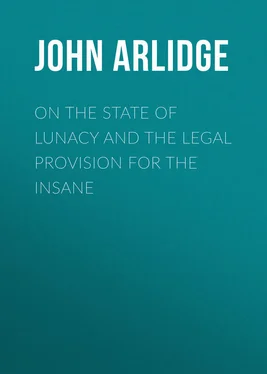John Arlidge - On the State of Lunacy and the Legal Provision for the Insane
Здесь есть возможность читать онлайн «John Arlidge - On the State of Lunacy and the Legal Provision for the Insane» — ознакомительный отрывок электронной книги совершенно бесплатно, а после прочтения отрывка купить полную версию. В некоторых случаях можно слушать аудио, скачать через торрент в формате fb2 и присутствует краткое содержание. ISBN: , Жанр: foreign_antique, foreign_prose, на английском языке. Описание произведения, (предисловие) а так же отзывы посетителей доступны на портале библиотеки ЛибКат.
- Название:On the State of Lunacy and the Legal Provision for the Insane
- Автор:
- Жанр:
- Год:неизвестен
- ISBN:http://www.gutenberg.org/ebooks/44320
- Рейтинг книги:3 / 5. Голосов: 1
-
Избранное:Добавить в избранное
- Отзывы:
-
Ваша оценка:
- 60
- 1
- 2
- 3
- 4
- 5
On the State of Lunacy and the Legal Provision for the Insane: краткое содержание, описание и аннотация
Предлагаем к чтению аннотацию, описание, краткое содержание или предисловие (зависит от того, что написал сам автор книги «On the State of Lunacy and the Legal Provision for the Insane»). Если вы не нашли необходимую информацию о книге — напишите в комментариях, мы постараемся отыскать её.
On the State of Lunacy and the Legal Provision for the Insane — читать онлайн ознакомительный отрывок
Ниже представлен текст книги, разбитый по страницам. Система сохранения места последней прочитанной страницы, позволяет с удобством читать онлайн бесплатно книгу «On the State of Lunacy and the Legal Provision for the Insane», без необходимости каждый раз заново искать на чём Вы остановились. Поставьте закладку, и сможете в любой момент перейти на страницу, на которой закончили чтение.
Интервал:
Закладка:
In their Twelfth Report (1858) the Commissioners in Lunacy attempt to calculate the probable demands for asylum accommodation on the 1st of January 1860, from the increased number of lunatics in the space of one year, from January 1st, 1857, to January 1st, 1858, amounting to 915. But as we have pointed out in a paper in the “Journal of Mental Science” (vol. v. 1859, p. 249), the conclusion drawn from such data must be fallacious. For instance, a calculation on the result of one year’s statistics is evidently worth little. There are many causes at work in asylums which materially affect the relative number of admissions and discharges, and consequently produce an inequality in the rate of increase viewed year by year. Moreover, where the same plan of calculation has been adopted in determining what asylum accommodation was necessary, experience has soon exhibited the fallacy, and both the admissions and the demands for admission have far exceeded the total reckoned upon. To arrive at a nearer approximation to the truth, the augmentation in the number of lunatics ought to be noted for a space of several years; and to make the deduction more satisfactory, the increase of the general population, the conditions of the period affecting the material prosperity of the people, and its political aspects; and, lastly, the mere circumstance of the opening of new asylums, – a circumstance always followed by an unexpected influx of patients, need be taken into account.
In the preceding considerations only the returns of lunatics in Asylums, Hospitals, and Licensed Houses are discussed; but, as we have seen, there is an almost equally large number detained in workhouses, or boarded with their relatives, or other persons, at the expense of their parishes, whose increase or decrease is a matter of kindred importance. On reviewing the returns of their numbers at periods when they have been taken cognizance of by the Lunacy Commission, we find that there were in workhouses and elsewhere, together, in

exhibiting an increase of 4342 in the ten years between 1847 and 1857, and a decrease in the four between 1843 and 1847 of 1384, owing, doubtless, to the opening of new asylums during that space of time. The returns of the two classes of Pauper Lunatics together being both so infrequently made, and, as before shown (p. 8), open to criticism on account of their incompleteness, we shall attempt to arrive at a more correct estimate of increase than that just made. In the first place, with respect to Union Workhouses, the Summary of Indoor Paupers, published by the Poor Law Commission (10th Report, p. 196), affords the necessary data. According to this tabular statement, we find, that, there were on the 1st of January in each of the ensuing years the following numbers of pauper lunatics: —

These columns show, that since 1847 the minimum number of insane, at a corresponding date in each year, occurred in 1850. Once indeed since, but at a different period of the year, viz. on July 1st, 1851, the number fell to 4574, or 75 less than at the date before named. Two or three years excepted, the increment has been progressive; at one time, indeed, much more rapidly so than at another. The fluctuations observable are, in the first place, due to the opening of new, or the repletion of existing, asylum accommodation; and in a lesser degree, to the rise or fall of pauperism in the community at large, or to an increased mortality at times, as, for example, in 1849, when cholera prevailed – an event which in part, at least, explains the smaller figure of insane inmates in 1850.
But whatever the fluctuations observable year by year may be, there is a most distinct increase in the space of any five or ten years selected from the list, suggestive of the unwelcome fact that, notwithstanding the very large augmentation of asylum accommodation and the reduction of numbers by death, the rate of accumulation has proceeded in a ratio exceeding both those causes of decrease of workhouse inmates combined. Thus, to take the decennial period between 1847 and 1857, we discover an increase of just 2000, or an average annual one of 200; and, what is remarkable, as large a total increase, within a few units, is met with in the quinquennial period between 1853 and 1858, and consequently the yearly average on the decennial period is doubled; viz. 400 instead of 200. This doubling of the average in the last five years would be a more serious fact, were it not that in 1853 the number of workhouse inmates had been reduced upon 1851, and had only slightly advanced above that of 1849.
Rejecting the maximum rate of accumulation, we will calculate the average of the last three years cited, from 1855 to 1858, a period during which there has been no notable cause of fluctuation, and no such increase of population as materially to affect the result, and for these reasons better suited to the purpose. In this space of time the increment equalled 987, or an average of 329 per annum; which may fairly be considered to represent the rate of accumulation of lunatics in Union Workhouses at the present time.
The absence of returns of lunatics in the workhouses of parishes under local Acts, is an obstacle to a precise computation of them; however, on the assumption that the proportion of lunatics in those workhouses to the population (1,500,000) of the parishes they belong to, is equal to that of those in Union Workhouses to the estimated population (18,075,000) of the Unions, and that the average increase is proportionate in the two cases, this increase should equal 1⁄12th of 329, or somewhat more than 27, per annum; making the total average rate of accumulation in workhouses at large 356 annually.
Unfortunately, no separate record is regularly kept of those poor insane persons who are boarded with friends or others, and their number has been only twice published, viz. in 1847 and 1857, when, as seen in a preceding page, it was, respectively, 3465 and 5497. These two sums exhibit an increase of 2032 to have accrued in the ten years included between those dates, or an average one of 203 per annum.
We have, above, calculated the average annual increase on those in Union Workhouses and those with friends, at 434 annually; and consequently that of the latter being 203, the yearly increase of the former stands, according to the returns employed, at 231. However, we have proved that the average increase, in Union Workhouses, has reached in the last three years the amount of 329, and in workhouses at large 356, which, added to 203, produces 559, or in round numbers, 560, as the sum-total of accumulation of pauper lunatics not in Asylums, Hospitals, or Licensed Houses. Adding the annual rate of increase of the insane in Asylums, viz. 980, to that among paupers, unprovided with asylum accommodation, 560, we obtain the total accumulation per annum of 1540 lunatics reported to the public boards. To this sum there should rightly be added the accumulative increase among insane persons not known to those boards, and which, in the absence of any means to ascertain its amount, may be not extravagantly conceived to raise the total to 1600.
We come now to the second part of our present task, viz. to discover the comparative number of new cases in several past years, so as to obtain an answer to the question, – Has there been an increase of the annual number of persons attacked with lunacy during that period? for previous figures leave no doubt there is an augmented ratio of insane persons in the population of the country. At the outset of this inquiry an insuperable difficulty to a correct registration of the number arises from the circumstance that, during any term of years we may select, the accommodation for the insane has never, even for one year, been fixed, but has been progressively increased by the erection of new, and the enlargement of old asylums. This occurrence, necessarily, very materially affects the returns made by the Commissioners of the number of admissions into asylums and Licensed Houses. Even if the comparison of the annual admissions into any one County Asylum only, were of value to our purpose, the same difficulty would ensue by reason of the enlargement of the institution from time to time, and of the circumstance that, as it progressively filled with chronic cases, the number of admissions will have grown smaller. Likewise, the farther that the inquiry is extended back, the more considerable will this difficulty in the desired computation be. In short, it may be stated generally, that the proportion of admissions will vary almost directly according to the accommodation afforded by asylums, and the inducements offered to obtain it.
Читать дальшеИнтервал:
Закладка:
Похожие книги на «On the State of Lunacy and the Legal Provision for the Insane»
Представляем Вашему вниманию похожие книги на «On the State of Lunacy and the Legal Provision for the Insane» списком для выбора. Мы отобрали схожую по названию и смыслу литературу в надежде предоставить читателям больше вариантов отыскать новые, интересные, ещё непрочитанные произведения.
Обсуждение, отзывы о книге «On the State of Lunacy and the Legal Provision for the Insane» и просто собственные мнения читателей. Оставьте ваши комментарии, напишите, что Вы думаете о произведении, его смысле или главных героях. Укажите что конкретно понравилось, а что нет, и почему Вы так считаете.












